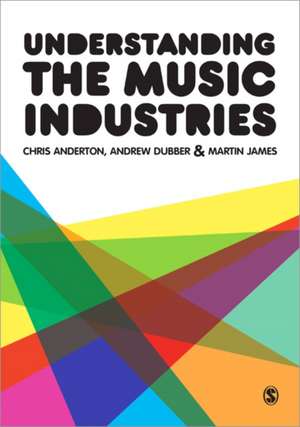Understanding the Music Industries
Autor Chris Anderton, Andrew Dubber, Martin Jamesen Limba Engleză Paperback – 13 dec 2012
• Takes the reader on a journey from Glastonbury and the X-Factor to house concerts and crowd-funded releases;
• Demystifies management, publishing and recording contracts, and the world of copyright, intellectual property and music piracy;
• Explains how digital technologies have changed almost all aspects of music making, performing, promotion and consumption;
• Explores all levels of the music industries, from micro-independent businesses to corporate conglomerates;
• Enables students to meet the challenge of the transforming music industries.
This is the must-have primer for understanding and getting ahead in the music industries. It is essential reading for students of popular music in media studies, sociology and musicology.
Preț: 402.45 lei
Nou
Puncte Express: 604
Preț estimativ în valută:
77.01€ • 80.61$ • 64.10£
77.01€ • 80.61$ • 64.10£
Carte tipărită la comandă
Livrare economică 31 martie-14 aprilie
Preluare comenzi: 021 569.72.76
Specificații
ISBN-13: 9781446207956
ISBN-10: 1446207951
Pagini: 248
Dimensiuni: 170 x 242 x 14 mm
Greutate: 0.44 kg
Ediția:New.
Editura: SAGE Publications
Colecția Sage Publications Ltd
Locul publicării:London, United Kingdom
ISBN-10: 1446207951
Pagini: 248
Dimensiuni: 170 x 242 x 14 mm
Greutate: 0.44 kg
Ediția:New.
Editura: SAGE Publications
Colecția Sage Publications Ltd
Locul publicării:London, United Kingdom
Recenzii
This is an invaluable book for anyone who wants to know how the modern music industry works. Students will find it clear and enjoyable to read, musicians will find it revealing and helpful, and budding music entrepreneurs will find it provides real insights. It is up-to-date, informed by the realty of the modern music business, and balances theory with practice.
Tim Wall
Professor of Radio and Popular Music Studies, Birmingham City University
Tim Wall
Professor of Radio and Popular Music Studies, Birmingham City University
Cuprins
Introduction
Questioning 'Traditional' Models of the Music Industry
Structure of the Book
1. Studying the Music Industries
Key Findings
Getting Started
Organizational Structure
Political Economy
Culture Industry
Sociology
Musicology
Metanarrative
Historical Analysis
Technological Development
Media Ecology
Digital Technologies
Issues
Conclusion
Further Reading
2. The Recorded Music Industry
Key Findings
The Structure and Size of the Recording Industry
A Brief History of the Recorded Music Industry
The Majors: Business Structures and Characteristics
The Independent Sector: Definitions and Types
The Ideology of Independence
Strategies for Dealing with Uncertainty and Risk
Conclusion
Further Reading
3. Songwriting and Publishing
Key Findings
Songwriters, Performers and Publishers
Motivations
Songwriting as Commercial Practice
Songwriting Methods and Tools
Music Publishing
Traditional Income Streams
'New' Income Streams
Sampling
Conclusion
Further Reading
4. Music Production
Key Findings
Changing Models and the Mythology of the Recording Studio
The Production Process
Tracking
Mixing
Mastering
Manufacturing
Production Careers and Roles
Project Studios, MIDI, and Other Developments
Conclusion
Further Reading
5. Music Distribution
Key Findings
Introducing Music Distribution
Physical Distribution
Mass-Market Retailers
Independent Retailers
Second-Hand Retailers
Online Music Distribution
Streaming Services
Music Media Distribution
Unauthorized Distribution
Conclusion
Further Reading
6. Music Promotion
Key Findings
Marketing, Branding and Gatekeeping
The Promotional Campaign
Music Journalism
Radio
Television
Point of Sale Marketing (POS) and In-Store Music
Sponsorships and Endorsements
Grassroots Marketing
Social Media/Mobile Media
Conclusion
Further Reading
7. The Live Music Industries
Key Findings
The Resurgence of Live Music
A Brief History of the Live Music Industry
Motivations for Live Concert Touring
Authenticity and Live Performance
Live Music Sponsorship
Roles and Responsibilities
Live Performance Contracts
Concert and Festival Ticketing
The Relationship between the Recorded and the Live Music Industries
Conclusion
Further Reading
8. Music Audiences
Key Findings
Understanding Music Audiences
Music on the Move: From the Walkman to the iPhone
Music and Social Media Consumption
Heritage and Nostalgia
Record Collecting
Conclusion
Further Reading
9. Copyright and Music Piracy
Key Findings
Introducing Copyright
Copyright Basics
Key Terms in UK Copyright Law
US Copyright Law: Key Differences
Collection Societies
Music Piracy
Music Industry Responses to Piracy
Artist Responses to Piracy
Conclusion
Further Reading
10. Contractual Agreements and Relationships
Key Findings
Artist Management Agreements
Music Publishing Agreements
Recording Agreements
Conclusion
Further Reading
Conclusion
Complexity and Symbiosis
Be Wary of Metanarratives
Diversity and Reorganization
Where Next?
Glossary
Questioning 'Traditional' Models of the Music Industry
Structure of the Book
1. Studying the Music Industries
Key Findings
Getting Started
Organizational Structure
Political Economy
Culture Industry
Sociology
Musicology
Metanarrative
Historical Analysis
Technological Development
Media Ecology
Digital Technologies
Issues
Conclusion
Further Reading
2. The Recorded Music Industry
Key Findings
The Structure and Size of the Recording Industry
A Brief History of the Recorded Music Industry
The Majors: Business Structures and Characteristics
The Independent Sector: Definitions and Types
The Ideology of Independence
Strategies for Dealing with Uncertainty and Risk
Conclusion
Further Reading
3. Songwriting and Publishing
Key Findings
Songwriters, Performers and Publishers
Motivations
Songwriting as Commercial Practice
Songwriting Methods and Tools
Music Publishing
Traditional Income Streams
'New' Income Streams
Sampling
Conclusion
Further Reading
4. Music Production
Key Findings
Changing Models and the Mythology of the Recording Studio
The Production Process
Tracking
Mixing
Mastering
Manufacturing
Production Careers and Roles
Project Studios, MIDI, and Other Developments
Conclusion
Further Reading
5. Music Distribution
Key Findings
Introducing Music Distribution
Physical Distribution
Mass-Market Retailers
Independent Retailers
Second-Hand Retailers
Online Music Distribution
Streaming Services
Music Media Distribution
Unauthorized Distribution
Conclusion
Further Reading
6. Music Promotion
Key Findings
Marketing, Branding and Gatekeeping
The Promotional Campaign
Music Journalism
Radio
Television
Point of Sale Marketing (POS) and In-Store Music
Sponsorships and Endorsements
Grassroots Marketing
Social Media/Mobile Media
Conclusion
Further Reading
7. The Live Music Industries
Key Findings
The Resurgence of Live Music
A Brief History of the Live Music Industry
Motivations for Live Concert Touring
Authenticity and Live Performance
Live Music Sponsorship
Roles and Responsibilities
Live Performance Contracts
Concert and Festival Ticketing
The Relationship between the Recorded and the Live Music Industries
Conclusion
Further Reading
8. Music Audiences
Key Findings
Understanding Music Audiences
Music on the Move: From the Walkman to the iPhone
Music and Social Media Consumption
Heritage and Nostalgia
Record Collecting
Conclusion
Further Reading
9. Copyright and Music Piracy
Key Findings
Introducing Copyright
Copyright Basics
Key Terms in UK Copyright Law
US Copyright Law: Key Differences
Collection Societies
Music Piracy
Music Industry Responses to Piracy
Artist Responses to Piracy
Conclusion
Further Reading
10. Contractual Agreements and Relationships
Key Findings
Artist Management Agreements
Music Publishing Agreements
Recording Agreements
Conclusion
Further Reading
Conclusion
Complexity and Symbiosis
Be Wary of Metanarratives
Diversity and Reorganization
Where Next?
Glossary
Descriere
A must-have textbook for students of popular music. It fully explains all levels of the music industries and demystifies management processes, from contracts to copyright. Packed with case studies, it equips students with the critical tools to track ongoing developments.
















